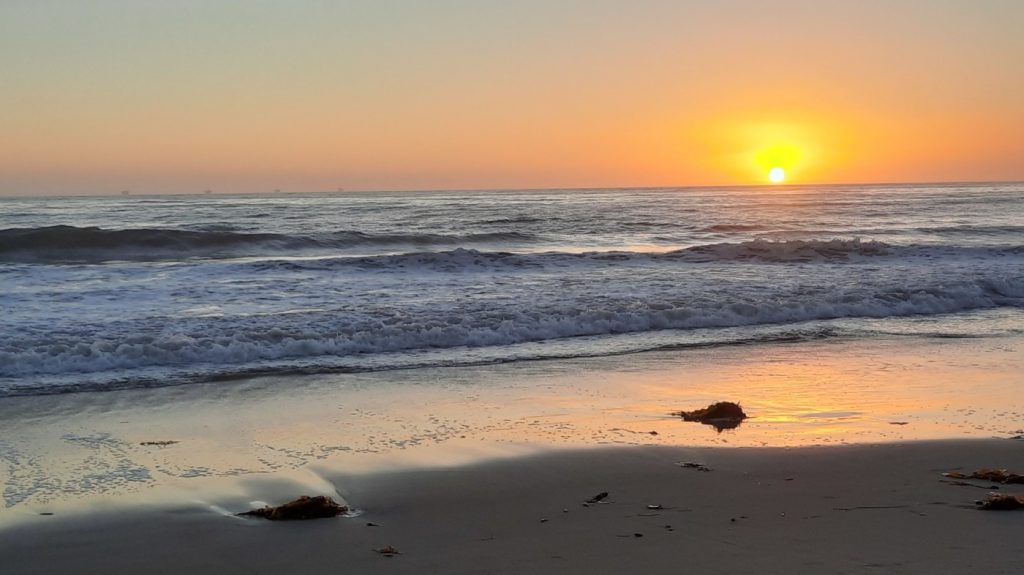Carpinteria, a small town some 12 miles outside Santa Barbara, says it is the home of “the world’s safest beach,” and for 90 years newspaper adverts have boasted of its clean, wide sands and lack of rip current.
Related Articles
Universal Studios Hollywood offers 15% discounts on annual passes
Stagecoach 2024: Set times, new layout and limited passes announced
Disneyland closes 4 attractions during busy festival season
He thought the guy he met on a California vacation 11 years ago was just a fling. He turned out to be the love of his life
China plans to send California zoo more pandas this year, reintroducing panda diplomacy
For me at least, the only danger here has been blotches of tar sticking to my feet.
It comes from an inland pit that outcrops onto the beach, and still oozes and glistens today. It was mined by the native Chumash people to waterproof their plank-built boats, and the carpentry of their village inspired 18th century Spanish explorers when they renamed the area.
On a clear day you can see oil rigs out in the ocean, but they are dwarfed by the outlines of several of the Channel Islands beyond. A total of eight make up the archipelago, and they are explored at the new Chrisman Channel Islands Center, which officially opens to the public April 4.
The new Chrisman Channel Islands Center explores the eight islands off California’s coast. (Photo by James Bartlett)
“We hope to expand to include all the islands right down to Baja California,” says executive director Emily Duncan, explaining that the center was the long-time goal of the Santa Cruz Island Foundation and especially Marla Daily, who has spent decades writing and researching islapedia.com, a website of more than 2,000 people whose lives intersected with the islands.
The center showcases a variety of artifacts from and about the islands, plus the industries based there in the past and present: cattle raising, wine-making, fishing, seal hunting and pottery, as well as tourism, art and even military use.
The exterior of the Chrisman Channel Islands Center features benches in the shape of islands and a statue of Juana Maria, the “Lone Woman” of San Nicholas Island who inspired the children’s book “Island of the Blue Dolphins.” (Photo by James Bartlett)
Outside, the native plant garden is dotted with sculpture, including metal benches in the shape and proportionate size of the islands. Santa Barbara Island is barely enough for a toddler to sit on.
There is also a statue of Juana Maria, the “Lone Woman” of San Nicholas Island and inspiration for “Island of the Blue Dolphins,” plus the Octopus’s Garden, which features a huge granite cephalopod, and donated whale bones and fossilized stones found on the islands.
The center is located at the top of Linden Avenue, the main street that leads all the way down to the ocean. On Linden you’ll find tourist-friendly stores and coffee shops, but also frozen bananas at Robitaille’s, our favorite lunch place The Cork Tree, and old-school seafood joint Little Dom’s.
This mural, trumpeting Carpinteria’s claim to have the “world’s safest beach” is on Wulbrandt Way near its intersection with Linden Avenue. (Photo by James Bartlett)
Also on Linden is the new Lantern Tree Books, which is located where Carpinteria’s first library opened in 1910. Lest you forget, it has a “world’s safest beach” mural on the side wall.
Right by the tiny Amtrak Station is The Spot, a burgers and milkshake shack, and you can go on towards the beach, or instead turn left into the 62-acre State Park, and take the 20-30 min walk past the RV park along the bluffs of the Nature Preserve towards the Seal Sanctuary.
Carpinteria’s Harbor Seal Statue is located off Linden Avenue, just inside Carpinteria State Beach. (Photo by James Bartlett)
From high above you look down on dozens of harbor seals lazing on the sand, and in the winter it’s a rookery for newborns. There are further hikes around, but instead turn back toward town and take a detour off the trail at Palm Avenue to visit Santa Barbara Hives and buy some avocado honey, or a charcoal sourdough sandwich — before they sell out.
Santa Barbara Hives in Carpinteria sells varieties of honey along with candles, cakes, jams, jellies and lip balm made with beeswax. (Photo by James Bartlett)
We have visited Carpinteria many times, and find that it’s not too tiring to combine a walk along the bluffs, which are dotted with twisted, wind-blown trees, with a lazy walk along the white sands. The beach is great for finding sea glass and shells, and you’ll often see dolphins swimming, and pelicans flying overhead.
These places — and popping in to see Wayne at Angel Antiques, which is always bursting with retro pieces and surfing artifacts — are always on our list, but more recently we have made discoveries off the main drag.
After asking the locals, I found that many of them tend to gravitate towards a relatively anonymous industrial-looking area known as The Lot, which is near the 101 Exit from Santa Barbara at the western end of Carpinteria Avenue.
The BrewLab has been serving craft beer in Carpinteria for 10 years. (Photo by James Bartlett)
Within a few steps of each other behind gray/black storefronts are several businesses including the friendly and innovative BrewLab, a taproom which is celebrating 10 years of making unique but often delicious beers.
BrewLab is a taproom that has been serving unique but often delicious beers in Carpinteria. (Photo by James Bartlett)
On the walls are portraits by local artist Ruairi Bateson, who was at the bar enjoying a drink during our visit, and advised us on a flight of eclectic IPAs. “You can’t go wrong with anything here,” he promised.
Next to BrewLAB is the Rincon Mountain Winery, the only one located in Carpinteria.
Rincon Mountain Winery is the only vintner in Carpinteria. Its tasting room features stacks of old vinyl records. (Photo by James Bartlett)
Inside, one wall is stacked floor-to-ceiling with old vinyl, which is played behind the bar on turntables. There’s a heavy accent on jazz, blues and big band, but also plenty of 1960s, ’70s and ’80s staples.
Christian Baker, brother of co-owner Jill Siple, poured a sample of Salvadorean red and explained that they recently branched out into small, 90-gallon batches of beer named Smoke Mountain in tribute to what the original Chumash people called Rincon Mountain.
He steps outside, and points into the distance. “That’s Rincon Mountain. We make our beer there too, and we’re moving into cider.”
A real secret — one that I was first told by Dennis Mitchell, the man behind Carpinteria Valley Radio, and then by several others — was that a man named Luis makes family-recipe frozen and baked Argentinian empanadas at Che Empanadas, which is behind BrewLAB.
He is only there on Friday and Saturday, but knock on the door and he will tell you how to cook, hold and eat them. Otherwise, you can order them at BrewLAB, Rincon, and from nearby Apiary, a brewery that makes gluten-free mead, kombucha, and other honey-based beverages.
A walk along the bluffs in Carpinteria offers breathtaking views and can be combined with a stroll on the sand. (Photo by James Bartlett)
Round the corner — literally — from Rincon is Sade, a Turkish coffee shop owned by Istanbul-born Ali, who excitedly explains the way to make the best coffee, and how he started out selling baklava.
Bonbons, truffles and chocolates, an ideal complement to the coffee, are a few yards away at the French Chocolats du CaliBressan, and with the beach always close at hand, no wonder Mitchell, who moved here a couple of years ago, simply says:
“I love this town so much it flows.”
If you’re planning a visit, have a look at the Facebook Group for “Carpinteria — the World’s Safest Beach”, and you’ll see pictures from beach combers, sunset-chasers and dog lovers.
One last tip: petroleum jelly gets the tar off your feet!


